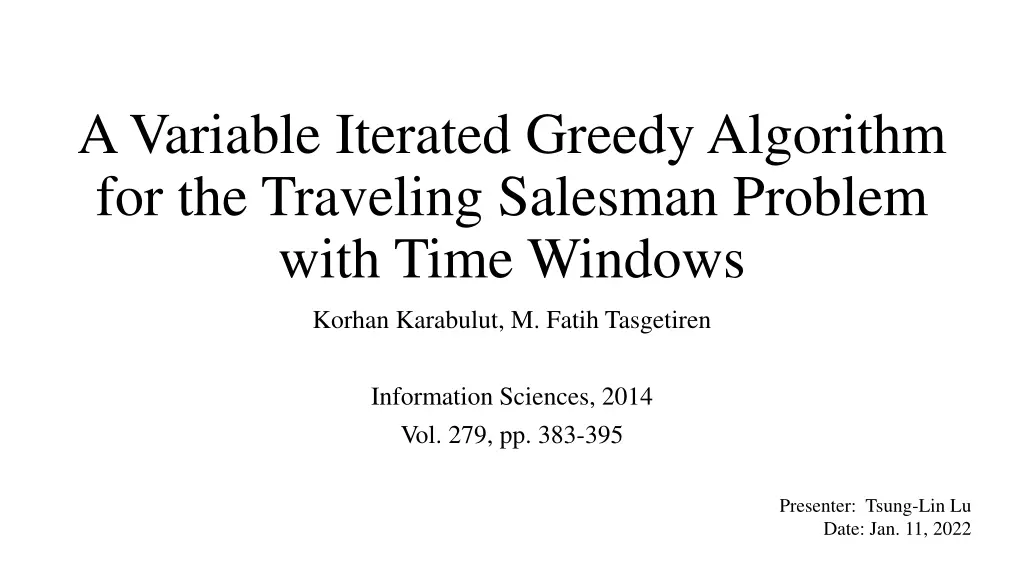
Variable Iterated Greedy Algorithm for Traveling Salesman Problem with Time Windows
Learn about the Variable Iterated Greedy Algorithm for solving the Traveling Salesman Problem with Time Windows (TSPTW). This algorithm minimizes total travel costs or makespan, showing competitive results with existing literature algorithms. Ideal for production scheduling and logistic operations optimization.
Download Presentation

Please find below an Image/Link to download the presentation.
The content on the website is provided AS IS for your information and personal use only. It may not be sold, licensed, or shared on other websites without obtaining consent from the author. If you encounter any issues during the download, it is possible that the publisher has removed the file from their server.
You are allowed to download the files provided on this website for personal or commercial use, subject to the condition that they are used lawfully. All files are the property of their respective owners.
The content on the website is provided AS IS for your information and personal use only. It may not be sold, licensed, or shared on other websites without obtaining consent from the author.
E N D
Presentation Transcript
A Variable Iterated Greedy Algorithm for the Traveling Salesman Problem with Time Windows Korhan Karabulut, M. Fatih Tasgetiren Information Sciences, 2014 Vol. 279, pp. 383-395 Presenter: Tsung-Lin Lu Date: Jan. 11, 2022
Abstract (1/2) This paper presents a variable iterated greedy algorithm for solving the traveling salesman problem with time windows (TSPTW) to identify a tour minimizing the total travel cost or the makespan, separately. The TSPTW has several practical applications in both production scheduling and logistic operations. The proposed algorithm basically relies on a greedy algorithm generating an increasing number of neighboring solutions through the use of the idea of neighborhood change in variable neighborhood search (VNS) algorithms. In other words, neighboring solutions are generated by destructing a solution component and reconstructing the solution again with variable destruction sizes. In addition, the proposed algorithm is hybridized with a VNS algorithm employing backward and forward 1_Opt local searches to further enhance the solution quality. 1
Abstract (2/2) The performance of the proposed algorithm was tested on several benchmark suites from the literature. Experimental results confirm that the proposed algorithm is either competitive to or even better than the best performing algorithms from the literature. Ultimately, new best- known solutions are obtained for 38 out of 125 problem instances of the recently proposed benchmark suite, whereas 15 out of 31 problem instances are also further improved for the makespan criterion. 2
Outline TSP with Time Windows (TSPTW) VIG_VNS Algorithm Variable Iterated Greedy Algorithm (VIG) Variable Neighborhood Search (VNS) Superiority of Feasible Solutions (SF) Adaptive Penalty Approach Results 3
TSP with Time Windows (TSPTW) Time C5, place e C4, place d C7, place g C1, place a C2, place b C3, place c C6, place f e2 l2 A tour visiting each node once, starting and ending at the depot. Cost c(i, j) = travel time (i j) + a service time at customer i. A time window [ei, li] : Customer i can't be serviced before eior visited later than li. A?k: arrival time at customer ?k. 4
VIG_VNS Algorithm Variable (V) : variable destruction sizes (d) Iterated (I) : while Greedy (G) : DestructConstruct() Variable Neighborhood Search (VNS) : VNS_1_Opt() Superiority of Feasible Solutions (SF) : <lex 5
Variable Iterated Greedy Algorithm (VIG) In an IG algorithm, there are two central procedures consisting of the destruction and the construction phases. DestructConstruct(?, 3) : Step1: Destruction. 0 5 1 3 4 6 9 2 8 7 0 0 5 3 4 9 2 8 0 + 1 6 7 Step2 : Construction. 0 1 5 3 4 9 2 8 0 0 5 1 3 4 9 2 8 0 0 5 3 1 4 9 2 8 0 0 5 3 4 1 9 2 8 0 0 5 3 4 9 1 2 8 0 0 5 3 4 9 2 1 8 0 Choose the best partial solution and keep it for the next iteration until the size of ? is n. 0 5 3 4 9 2 8 1 0 6
Variable Neighborhood Search (VNS) The destruction and construction procedure of iterated greedy algorithms. 1_Opt local search : A single node is removed. VNS_1_Opt(?) : Step1: Destruction. 0 4 2 1 5 3 0 0 4 2 1 5 0 + 3 Step2 : Construction. 0 4 2 1 3 5 0 0 4 2 3 1 5 0 Choose the best partial solution and keep it for the next iteration until the size of iteration is n 1. 0 4 3 2 1 5 0 0 3 4 2 1 5 0 7
Superiority of Feasible Solutions (SF) Constrained optimization based on lexicographic ordering, where constraint violation and objective function value are distinguished. ?ais deemed to be superior to ?b ?ais feasible, and ?bis not. ?aand ?bare both feasible, and ?ahas a smaller objective function value than ?b. ?aand ?bare both infeasible, but ?ahas a smaller overall constraint violation v(?a). 8
Adaptive Penalty Approach A near feasibility threshold (NFT) corresponds to a promising region beyond the feasible region. Cost Penalty NFT0is an upper bound for NFT ? is a user-defined positive parameter t is the iteration counter 9
Results (1/4) Intel Core i5 processor at 2.53 GHz. Five available sets of benchmark instances : n represents the number of customers. w is the time window width. Best is the best known or optimal value. 10
Results (4/4) In the five sets, avg values of GVNS and VIG_VNS are not statistically difference. VIG without a VNS local search was statistically equivalent to the VIG_VNS algorithm. 13
Abstract s 15
